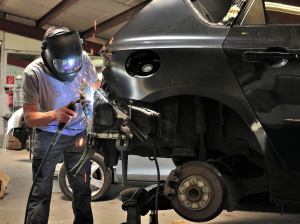Concrete Contractors are essential to the construction industry. They bring their specialized skills and expertise to a wide range of concrete projects. Their duties include project planning, site preparation, concrete pouring, finishing, and quality control.
Choosing the right contractor requires understanding the specifics of concrete as a material and having good communication and project management skills. Read on to learn more about what to look for in a concrete contractor. Contact Dynasty Concrete Contractors of Dallas now!

A contractor with a deep understanding of concrete materials and techniques can bring your construction vision to life. They will be able to accurately evaluate and estimate the costs of concrete work and provide solutions for any challenges that may arise on your project. This will help you stay within budget and ensure that your project is completed on time and to the highest quality standards.
In addition to technical expertise, a good concrete contractor will also have strong project management skills to keep the process moving forward on schedule and in line with your expectations. They will be able to effectively collaborate with architects, engineers, and clients to develop concrete construction plans that meet your needs. They will also be able to coordinate with subcontractors, suppliers, and other construction professionals to ensure that everyone is working together as efficiently as possible.
Concrete contractors specialize in all aspects of concrete construction, including design, preparation, and pouring. They work on a variety of projects, ranging from residential construction to large-scale infrastructure projects. They also perform repairs and restoration on existing concrete structures.
When evaluating potential concrete contractors, look for their certifications and associations with professional organizations. Memberships in organizations such as the National Ready Mixed Concrete Association and the American Concrete Institute show a commitment to ongoing education and industry standards. In addition, ask about their licensing and insurance. Licensing guarantees that the contractor is qualified to perform their work safely and according to local regulations. It is also important to find out if they are bonded, which will protect you in the event of any issues with the project or non-performance.
Lastly, be sure to ask for references from previous customers. This will give you a glimpse into their past work and help you determine whether they are the right fit for your project. If you are unsure about which concrete contractor to choose, be sure to contact several and request quotes for your project. This will allow you to compare prices and determine which contractor is the best fit for your budget and expectations.
Strong Communication Skills
Concrete Contractors must be able to clearly communicate with team members, customers, and general contractors. This is essential because it reduces misunderstandings and ensures that everyone understands exactly what is expected from them on the job site.
Effective communication skills can also help a concrete contractor manage project timelines effectively and efficiently. For example, it is important for a concrete contractor to use scheduling techniques like Gantt charts to plan and track project milestones, adjust schedules in case of unavoidable delays, and keep clients updated with the status of their projects.
It is also crucial for a concrete contractor to have strong problem-solving skills. Construction is a fast-paced industry and unexpected challenges are bound to arise, from weather conditions to equipment malfunctions. Being able to quickly analyze and solve these issues can save the project from unnecessary delays and keep the project on track.
Construction is a highly physical profession, so it is important for concrete subcontractors to have a high level of physical strength and endurance. They are often on their feet for several hours at a time and may have to lift heavy materials or equipment. Additionally, the work can be very repetitive and requires good attention to detail.
Having strong interpersonal skills is another important trait for a concrete contractor. They must be able to build trust with their team members and foster a positive work environment. This is especially important because it can help prevent conflict and improve productivity.
For example, it is important for a contractor to be able to explain the different types of concrete finishes to their client so that they can make an informed decision about their ideal finish. This is a great way to demonstrate that the contractor cares about their client’s satisfaction.
Finally, a concrete contractor should have strong management and leadership communication skills. These skills can help them navigate the complexities of project management and lead their teams successfully. For instance, they can use their management communication skills to handle processes and tasks while using their leadership communication skills to motivate and guide their team.
Strong Attention to Detail
Concrete contractors have an eye for detail, which is important to creating quality work. They can spot issues before they become a problem, which helps to ensure that projects are completed on time and within budget. They also understand how different concrete mixes behave, how environmental factors impact curing, and can troubleshoot common problems that may arise on the job.
While some might think that a concrete contractor’s only responsibility is to move dirt around on construction sites, the job actually involves much more than that. They are responsible for preparing a construction site for pouring foundations, walls, and other structures that require solid concrete support. This requires them to know how to make excavations safely and quickly. They must also be able to read blueprints and plans, which is essential for their success on the job.
This is a physical job that requires contractors to have remarkable strength and stamina. They spend a lot of their time bent over or on the ground, and must be able to work in hot or cold weather for long periods of time. Concrete is heavy, and it takes a strong, reliable body to lift and maneuver it. Contractors must also be able to stand for extended periods of time, which can be tiring.
When selecting a concrete contractor for your next project, be sure to ask for references and review their portfolio. Look at the quality of their work and their attention to detail, as well as their commitment to customer service. In addition, verify that they are licensed for your state and that they have liability insurance and worker’s compensation.
A strong, reliable concrete contractor can help you build a stable, durable structure that will last for years to come. When choosing a concrete contractor, take the time to select one with experience and a solid reputation. Be sure to request quotes from several licensed, insured, and reputable contractors. Compare their prices and services, and select a contractor with the best overall value and quality of work. By following these simple tips, you can be confident that your concrete project will be in good hands.
Strong Organizational Skills
Concrete Construction involves multiple stages and requires a wide range of skills to produce quality results. The contractor must be able to manage the construction process from start to finish while adhering to strict project specifications and timelines. Professional contractors also need to possess strong communication skills to collaborate with architects, engineers, and clients throughout the construction phase. Strong customer service orientation is vital to building trust and ensuring that the client is satisfied with the work completed by the concrete contractor.
When interviewing a potential concrete contractor, it is important to determine their experience and knowledge of the industry. You can verify the contractor’s credentials by asking for references and requesting copies of their worker’s compensation insurance, liability insurance, and business license.
A good concrete contractor will have a portfolio of completed projects that demonstrate their ability to deliver high-quality results. This will help you assess whether their services will meet your needs and budget. It is also helpful to ask about any specialized training or certifications they may have.
Besides technical expertise, a strong customer service orientation and organizational skills are essential for any concrete contractor. The contractor should be able to answer questions and address concerns promptly, making it easy for the client to make decisions throughout the process. The contractor should also be able to translate industry jargon into language that is understandable by the average person. The contractor should keep the client updated on the progress of the project at all times and never trouble them with unexpected changes in costs or deadlines.
Another key organizational skill for a concrete contractor is the ability to prioritize and stay focused on tasks at hand. They must be able to accurately gauge how much time is needed for each task and then allocate adequate resources accordingly. They must also be able to recognize when equipment or supplies are low, so that they can place orders with reputable suppliers in a timely manner.
It is also important for a concrete contractor to be able to think on their feet and remain alert during the workday. Any unexpected challenges that arise can disrupt the schedule and cause delays in completion. Having strong problem-solving skills helps the contractor avoid costly mistakes and provide customers with a positive overall experience.


